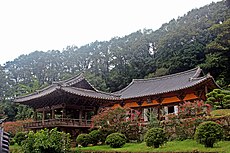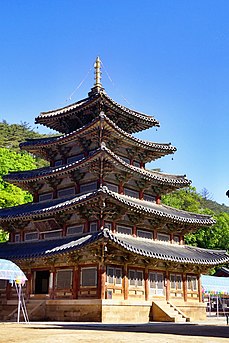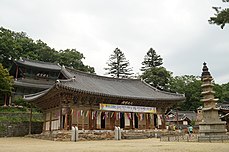Sansa (temple)
| Sansa | |
 | |
| Korean name | |
|---|---|
| Hangul | 산사 |
| Hanja | 山寺 |
Sansa (Korean: 산사; Hanja: 山寺) is a Buddhist mountain monastery in Korea. Seven of them are designated as UNESCO World Cultural Heritage.[1] With the country being largely mountainous and Buddhism deeply rooted in its history, there are many Sansas across the country.
The word Sansa is composed of two words san and sa which mean mountain and monastery/temple.
World Heritage listed Sansas[]
| Sansa | Location | Est | |
|---|---|---|---|

|
Tongdosa | Yangsan | 646[2] |

|
Buseoksa | Yeongju | 676[2] |

|
Bongjeongsa | Andong | 677[2] |

|
Beopjusa | Boeun County | Mid 8th Century[2] |

|
Magoksa | Gongju | Latter half of the 9th Century[2] |

|
Seonamsa | Suncheon | Latter half of the 9th Century[2] |

|
Daeheungsa | Haenam County | Latter half of the 9th Century[2] |
See also[]
References[]
- ^ "Mountain temples join Unesco list : Sansa are at least 1,000 years old and contain unique Korean elements". koreajoongangdaily.joins.com. Retrieved 2021-02-14.
- ^ a b c d e f g "Nomination of Sansa, Buddhist Mountain Monasteries in Korea: For Inscription on the World Heritage List". whc.unesco.org. UNESCO. Retrieved 2021-11-26.
Categories:
- World Heritage Sites in South Korea
- Buddhist temples in South Korea
- Korean traditions
- Korean culture